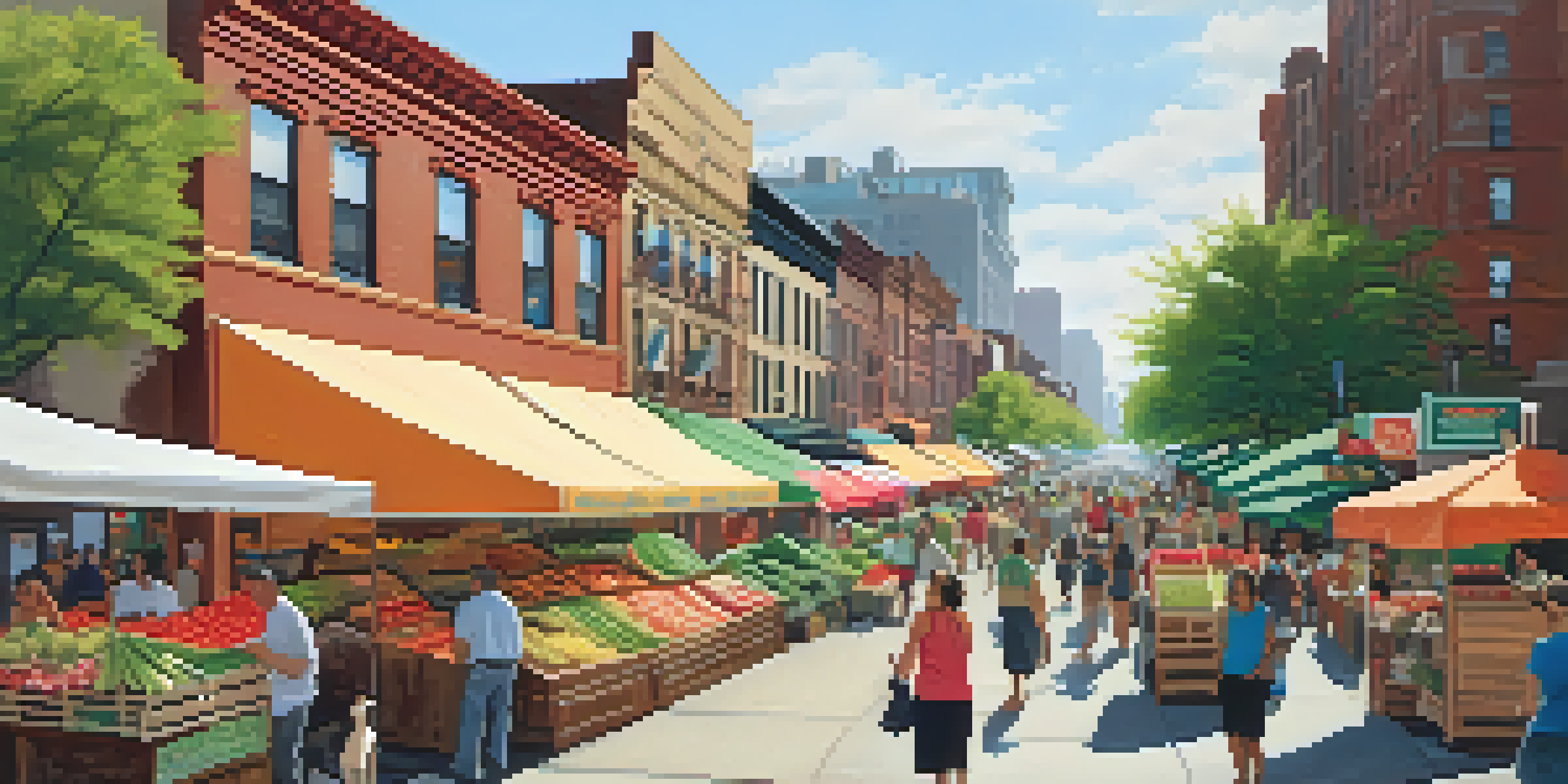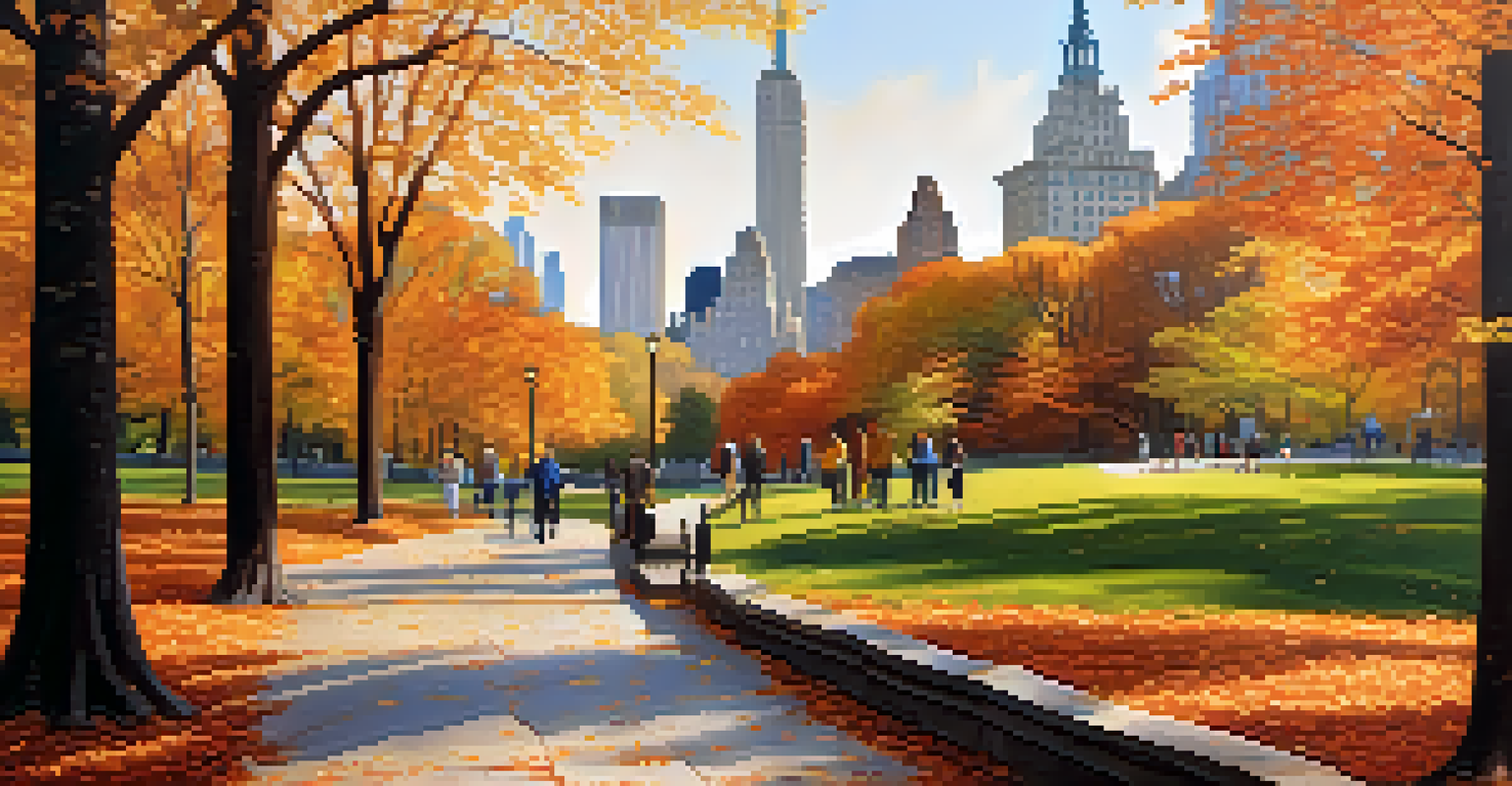How NYC's Neighborhoods Inspire Filmmaking and Storytelling

The Unique Character of Each NYC Neighborhood
New York City is a tapestry of neighborhoods, each with its own distinct personality. From the vibrant street art of Bushwick to the historic charm of Greenwich Village, these areas provide filmmakers with rich backdrops and unique stories. This diversity not only enhances visual storytelling but also allows for a variety of cultural narratives to be explored on screen.
New York is not a city; it's a world.
Filmmakers often draw inspiration from the everyday lives of the people who inhabit these neighborhoods. For example, the bustling markets of Jackson Heights or the serene parks of Prospect Lefferts Gardens can serve as settings that reflect the local culture. This authenticity resonates with audiences, making the stories relatable and engaging.
Moreover, the neighborhoods themselves can almost become characters in their own right. Think of how Central Park has served as a romantic escape in countless films or how the gritty streets of the Lower East Side have portrayed struggles and triumphs. This deep connection between place and storytelling is a hallmark of New York cinema.
Iconic Films That Showcase NYC's Neighborhoods
Many iconic films have showcased New York City's neighborhoods, leaving a lasting impression on both audiences and future filmmakers. Movies like 'Do the Right Thing' highlight the vibrant culture of Brooklyn, while 'Breakfast at Tiffany's' captures the elegance of the Upper East Side. These films not only tell stories but also celebrate the unique essence of their settings.

For instance, 'Her' transports viewers to the futuristic yet familiar streets of downtown Manhattan, blending the city’s architecture with a love story. Such films create a sense of place that is intrinsically tied to their narratives, making them unforgettable. The way these neighborhoods are depicted can influence perceptions and inspire future generations of storytellers.
NYC Neighborhoods Shape Filmmaking
The unique character of each NYC neighborhood enriches storytelling by providing filmmakers with vibrant backdrops and cultural narratives.
In addition, documentaries often explore the social issues present in various neighborhoods, providing a raw and honest look at life in the city. Films like 'The Bronx is Burning' reveal the complexities and challenges of urban life, encouraging discussions that go beyond entertainment. These cinematic portrayals can spark interest in the neighborhoods themselves, drawing visitors to explore their rich histories.
The Role of Local Culture in Filmmaking
New York City's neighborhoods are a melting pot of cultures, and this diversity enriches the storytelling landscape. Filmmakers often weave cultural elements into their narratives, reflecting the lives and experiences of the residents. This not only adds depth to the stories but also honors the heritage of the communities being portrayed.
The city is a labyrinth of stories waiting to be told.
For example, films like 'In the Heights' celebrate the vibrant Latino culture of Washington Heights, showcasing music, dance, and community spirit. Such representations foster a sense of belonging and pride among locals while educating wider audiences about different cultures. This cultural exchange is a powerful tool for storytelling in a city as diverse as NYC.
Furthermore, local events, festivals, and traditions often inspire filmmakers to incorporate real-life experiences into their scripts. The annual West Indian Day Parade in Brooklyn, for instance, serves as a colorful backdrop for films that explore themes of identity and community. By highlighting these rich cultural tapestries, filmmakers can create stories that resonate with people from all walks of life.
New York as a Stage for Global Narratives
While NYC is deeply rooted in American culture, it also serves as a stage for global narratives. The city's neighborhoods reflect a microcosm of the world, attracting filmmakers from various backgrounds who bring their stories to life. This international perspective enriches the cinematic landscape, making it a hub for diverse storytelling.
For instance, films like 'Lost in Translation' and 'The Last Black Man in San Francisco' showcase the themes of displacement and belonging, echoing the experiences of many urban dwellers. Through the lens of different cultures, these films highlight universal emotions and experiences, creating a bridge between diverse audiences. This interconnectedness is a testament to New York's role as a global cultural capital.
Cultural Diversity Enhances Stories
Filmmakers incorporate local culture and events, reflecting the diverse experiences of residents and creating relatable narratives.
Additionally, filmmakers often use NYC's neighborhoods to explore pressing social issues that transcend borders. From gentrification to identity politics, these stories resonate with viewers worldwide, prompting important conversations. The city’s ability to encapsulate these themes makes it a powerful backdrop for storytelling that speaks to the human experience.
The Impact of Filming Locations on Community
Filmmaking in NYC neighborhoods can have a profound impact on local communities. When a neighborhood is featured in a film, it often attracts attention, tourism, and economic opportunities. However, this influx can also lead to challenges, such as gentrification and displacement, which filmmakers must navigate responsibly.
For example, the popularity of 'Friends' has turned Greenwich Village into a tourist hotspot, which can be a double-edged sword. While the local economy benefits from increased foot traffic, long-time residents may feel the pressure of rising rents and changing demographics. Filmmakers and local communities must work together to ensure that the benefits of filming extend to everyone.
Moreover, community engagement in filmmaking can foster pride and ownership among residents. Initiatives that involve locals in the storytelling process can help create authentic representations of their lives. By prioritizing the voices of those who call these neighborhoods home, filmmakers can create narratives that are not only entertaining but also respectful and inclusive.
How Filmmakers Use NYC's Architecture and Landmarks
New York City's stunning architecture and iconic landmarks play a crucial role in filmmaking. From the towering skyscrapers of Manhattan to the historic brownstones of Brooklyn, these structures provide a visually striking backdrop that can enhance a film's narrative. Filmmakers often use these settings to evoke emotions and create memorable scenes.
For example, the Brooklyn Bridge has become a symbol of connection and love in films like 'Once Upon a Time in America.' Similarly, the Empire State Building is frequently featured in romantic comedies, representing dreams and aspirations. These landmarks are not just physical locations; they embody the spirit of New York and serve as integral elements in storytelling.
Local Communities Impact Filmmaking
Filming in neighborhoods can boost local economies but also poses challenges like gentrification, highlighting the need for community engagement.
Additionally, filmmakers often highlight lesser-known architectural gems that give a more nuanced view of the city. By showcasing hidden corners and unique buildings, they can create a sense of discovery for audiences. This exploration of architecture adds depth to the narrative, inviting viewers to experience the richness of New York beyond its most famous sights.
The Future of Filmmaking in NYC Neighborhoods
As technology and storytelling evolve, so too does filmmaking in New York City's neighborhoods. The rise of digital platforms and independent films has democratized the filmmaking process, allowing more voices and stories to emerge. This shift presents exciting opportunities for filmmakers to capture the essence of their communities authentically.
Moreover, with the growing emphasis on diversity and representation in storytelling, NYC neighborhoods are more likely to be featured in films that resonate with a broader audience. Filmmakers are increasingly aware of the importance of depicting realistic portrayals of varied cultural experiences, leading to richer and more compelling narratives. This trend reflects a growing recognition of the power of storytelling in shaping societal perceptions.

Looking ahead, collaboration between filmmakers and local communities will be vital to preserving the authenticity of these stories. By fostering partnerships, filmmakers can ensure that their narratives are not only entertaining but also meaningful and impactful. This synergy will continue to inspire future generations of storytellers to explore and celebrate the vibrant neighborhoods of New York City.